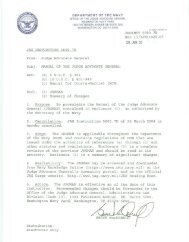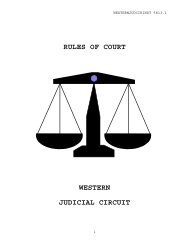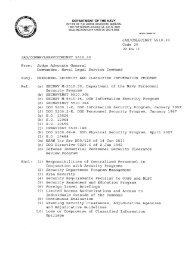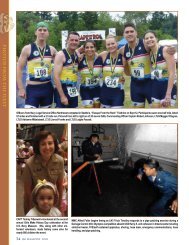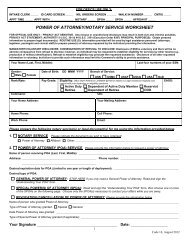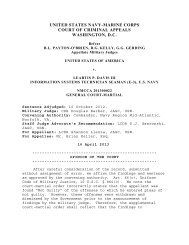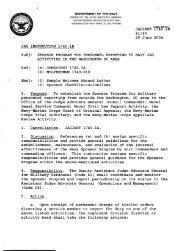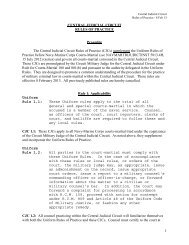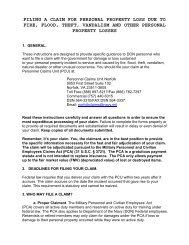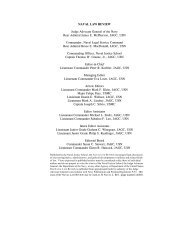JAGINST 1500.4A NJS - U.S. Navy Judge Advocate General's Corps
JAGINST 1500.4A NJS - U.S. Navy Judge Advocate General's Corps
JAGINST 1500.4A NJS - U.S. Navy Judge Advocate General's Corps
Create successful ePaper yourself
Turn your PDF publications into a flip-book with our unique Google optimized e-Paper software.
DEPARTMENT OF THE NAVY<br />
OFFICE OF THE JUDGE ADVOCATE GENERAL<br />
1322 PATTERSON AVENUE SE, SUITE 3000<br />
WASHINGTON NAVY YARD DC 20374-5066<br />
IN REPLY REFER TO:<br />
<strong>JAGINST</strong> 15 00.4A<br />
<strong>NJS</strong><br />
OCT 1 7 2012<br />
JAG I NSTRUCTION 1500 . 4A<br />
From:<br />
Subj :<br />
Ref:<br />
Encl:<br />
<strong>Judge</strong> Advocat e General<br />
JAG CORPS TRAINING PROGRAM<br />
(a ) SECNAVINST 5430.27[series]<br />
(b) COMNAVLEGSVCCOMINST 5800.1[series]<br />
(c) <strong>JAGINST</strong> 1150.2[series]<br />
(d) JAG/CNLSCINST 1500.2[series]<br />
(e) JAGI NST 1520.1[series]<br />
(f) <strong>JAGINST</strong> 3300.1[series]<br />
(g) JAG/COMNAVLEGSVCCOMINST 12410.1<br />
(h) OPNAVINST 1500.22[seri es]<br />
(i) Uniform Code of Military Justice<br />
(j) OPNAVINST 1500.81<br />
(k) NAVJUSTSCOLINST 1500<br />
(1) JAG/CNLSCINST 1500.1<br />
(1) Prof essional Development Standards (PDS) Program<br />
(2) Professional Military Education (PME) Program<br />
(3) Joint Professional Military Education (JPME) Guidance<br />
(4) Instructions for Developing a Command Training Plan<br />
(5) Sample PDO Monthly Report<br />
(6) Regional Training Authorities (RTA)<br />
(7) Sample RTA Report<br />
1. Purpose . To promulgate policy, prescribe procedures , and<br />
assign responsibilities for implementing a training program<br />
designed to ensure the delivery of high- quality legal services .<br />
Per referen ce (a) , the <strong>Judge</strong> <strong>Advocate</strong> General (JAG) is the<br />
capability sponsor for the <strong>Navy</strong> <strong>Judge</strong> <strong>Advocate</strong> <strong>General's</strong> <strong>Corps</strong><br />
(JAGC) , and is responsible for maintaining the JAGC legal<br />
community and de termining the best possible allocation o f<br />
avai lable JAGC community assets .<br />
2. Cancellation. <strong>JAGINST</strong> 1500.1A and <strong>JAGINST</strong> 1500.4 are h e reby<br />
cancelle d.
<strong>JAGINST</strong> <strong>1500.4A</strong><br />
OCT 1 7 2012<br />
3. Applicability. This instruction applies to all active-duty<br />
<strong>Navy</strong> <strong>Judge</strong> <strong>Advocate</strong>s (JA) , Limited Duty Officers (Law) ,<br />
Legalmen, and civilians working under the cognizance of the JAG.<br />
4. Background. As Special Assistant for Training, Commanding<br />
Officer, Naval Justice School (<strong>NJS</strong>) is entrusted with the<br />
development and execution of JAGC training programs. This<br />
instruction provides the framework for developing and providing<br />
appropriate training for all JAGC personnel throughout their<br />
careers, commensurate with the billets and positions to which<br />
those personnel are currently assigned or likely will be<br />
assigned.<br />
5. Policy.<br />
a. Training Continuum. The training programs implemented<br />
by this instruction must be continually improved to contribute<br />
to the highest quality legal services. All JAGC personnel will<br />
receive training, throughout their career, designed to prepare<br />
them for the future leadership, management, and legal challenges<br />
they will encounter. References (b) through (k) provide<br />
additional details regarding training requirements for specified<br />
career tracks, billets, or categories of personnel.<br />
b. Programs. This instruction implements the JA, Legalman,<br />
and civilian training programs listed in references (b) through<br />
(k), as well as the following programs:<br />
( 1) ) ;<br />
(1) Professional Development Standards (PDS) (enclosure<br />
(2) Professional Military Education (PME) (enclosure<br />
(2)); and<br />
(3) Joint Professional Military Education (JPME)<br />
(enclosure ( 3) ) .<br />
6. Action.<br />
a. Commander, Naval Legal Service Command (CNLSC), shall<br />
monitor the implementation and management of this training<br />
program, and shall keep the JAG apprised of NLSC command<br />
implementation of this instruction.<br />
2
<strong>JAGINST</strong> <strong>1500.4A</strong><br />
OCT 17 2012<br />
b. Special Assistant for Training/Commanding Officer, <strong>NJS</strong><br />
shall:<br />
(1) Maintain oversight, management, and responsibility<br />
for all JAGC personnel training;<br />
(2) Annually, convene a formal meeting of the <strong>NJS</strong> Board<br />
of Advisors (BOA) . CNLSC serves as Chair and selects the<br />
membership of the BOA. Commanding Officer, <strong>NJS</strong> serves as Vice<br />
Chair and schedules the BOA each year at a time conducive to the<br />
advisors' schedules;<br />
(3) Develop and implement such additional instructional<br />
programs as may be prescribed by the JAG based upon the<br />
requirements of references {a) through {k) , other competent<br />
authority, or the recommendation of the BOA;<br />
(4) Publish the annual (fiscal year basis) schedule of<br />
courses, as approved by the BOA;<br />
(5) Ensure that Basic Lawyer Course (BLC) students who<br />
meet all applicable qualifications at the time of graduation<br />
from the BLC are certified and sworn under Articles 27(b) and<br />
42(a) of reference (i) prior to departing <strong>NJS</strong>;<br />
(6) Task OJAG/NLSC subject matter experts as required to<br />
maintain PDS and PME modules;<br />
(7) Promulgate an <strong>NJS</strong>NOTE detailing the PME course of<br />
instruction for each fiscal year; and<br />
(8) Manage the Legalman Paralegal Education Program<br />
(LPEP) in accordance with references (d) and (j).<br />
c. The BOA shall approve the schedule of courses and<br />
allocation of Centrally Managed Training Funds for the following<br />
fiscal year.<br />
d. Region Legal Service Office (RLSO) and Defense Service<br />
Office (DSO) Commanding Officers shall:<br />
(1) Emphasize the importance of training in the<br />
provision of quality legal services and professional<br />
development;<br />
(2) Develop a Command Training Plan (enclosure (4)),<br />
submitted biannually for <strong>NJS</strong> review;<br />
3
<strong>JAGINST</strong> 1500. 4A<br />
OCT 1 7 2012<br />
(3) Ensure maximum participation in training and<br />
education programs, such as LPEP, <strong>NJS</strong> (and other service legal<br />
courses), PME, and JPME;<br />
(4) Ensure first-tour JAs complete PDS and PME modules;<br />
(5) Serve as Regional Training Authority (RTA)<br />
(enclosure (6));<br />
(6) Provide <strong>NJS</strong> with a training report biannually, on<br />
30 April and 31 October. A sample report is located at<br />
enclosure (7); and<br />
(7) Ensure command compliance with reference (1) .<br />
e. Additionally, RLSO Commanding Officers shall:<br />
(1) Ensure the Professional Development Officer (PDO)<br />
provides a monthly training status report to the <strong>NJS</strong> PDO, with a<br />
copy to the Special Assistant for Strategic Planning (SASP) per<br />
paragraph 6.f. (11) and enclosure (5) of this instruction; and<br />
(2) Ensure the PDO has the authority to schedule<br />
mandatory training to accomplish the regional training mission.<br />
f. Professional Development Officers shall:<br />
(1) Track first-tour JA training requirements and<br />
completion within the RLSO area of responsibility (AOR) in<br />
accordance with the policies of this instruction;<br />
(2) Supervise and facilitate PDS completion and, as<br />
requested, provide supplemental PDS-directed training for the<br />
RLSO and the DSO;<br />
(3) Plan, schedule, and facilitate the PME program using<br />
local subject matter experts (SMEs), as required;<br />
(4) Monitor enrollment and course progression of all<br />
Legalman Paralegal Education Program (LPEP) students within the<br />
RLSO AOR;<br />
(5) Ensure RLSO personnel complete General Military<br />
Training (GMT) and all other required training in accordance<br />
with references (b) and (h) ;<br />
4
(6) Assist the RLSO Senior Enlisted Leader with<br />
monitoring the execution of the 52-week Legalman training<br />
program within the RLSO AOR;<br />
<strong>JAGINST</strong> <strong>1500.4A</strong><br />
OCT 1 7 2012<br />
(7) Provide eligible JAs within the RLSO AOR with all<br />
relevant information to pursue JPME;<br />
(8) Ensure RLSO compliance with the JAGC mentoring<br />
program (reference (1));<br />
(9) Communicate regularly with the <strong>NJS</strong> Academic<br />
Director/Operations Officer regarding training opportunities,<br />
quotas, and available funding;<br />
(10) Conduct administrative reviews of all civilian<br />
training requests submitted to the RLSO RTA;<br />
(11) Track training program metrics and prepare monthly<br />
reports (enclosure 5); and<br />
(12) Assist the RLSO RTA as required and other RTAs as<br />
directed.<br />
g. Individuals shall:<br />
(1) Complete GMT and all other required training in<br />
accordance with references (b) and (h) ;<br />
(2) For attorneys, comply with the licensing state's<br />
requirements to remain in good standing, including Continuing<br />
Legal Education (CLE) requirements. Utilization of military<br />
training to meet CLE requirements is highly encouraged; and<br />
(3) For first-tour JAs:<br />
(a) Attend all scheduled PME training evolutions;<br />
(b) Attend all scheduled PDS training evolutions;<br />
and<br />
(c) Provide monthly PDS completion data to the PDO;<br />
(d) Complete all PME and PDS modules within 24<br />
months of reporting to initial duty station. If this 24-month<br />
period is interrupted by a deployment or other assignment, the<br />
judge advocate will return to complete the rotation sequence.<br />
5
<strong>JAGINST</strong> <strong>1500.4A</strong><br />
OCT 17 2012<br />
(4) For Legalmen:<br />
(d) and (j);<br />
(a) Complete the LPEP in accordance with references<br />
(b) Participate, as required, in the 52-week<br />
Legalman training program.<br />
Distribution:<br />
Electronic only via the Office of the <strong>Judge</strong> <strong>Advocate</strong> General<br />
website, http://www.jag.navy.mil.<br />
6
Professional Development Standards (PDS) Program<br />
<strong>JAGINST</strong> <strong>1500.4A</strong><br />
OCT 1 7 2012<br />
1. Purpose. The JAG <strong>Corps</strong> PDS program is designed to ensure<br />
the professional development of all first-tour JAs. The PDS<br />
Program is divided into four separate modules: Legal<br />
Assistance, Defense Services, Trial Services, and Command<br />
Services. The modules may be completed in any order.<br />
a. PDS training modules are designed to ensure that all<br />
first-tour JAs participate in a standardized training regimen<br />
lasting the length of their first tour.<br />
b. The modules require first-tour JAs to observe more<br />
experienced JAs performing a series of legal duties, then<br />
perform those duties under supervision when appropriate. Firsttour<br />
JAs are required to serve clients and assist in cases<br />
whenever available.<br />
2. Policy. All first-tour JAs will be assigned a PDS for the<br />
practice area to which they are assigned upon reporting to a<br />
RLSO. Once assigned, first-tour JAs are expected to complete<br />
the PDS in the course of their regularly assigned duties. In<br />
the event that a PDS line item cannot be completed while<br />
providing legal advice to actual clients, the PDO will provide a<br />
sample fact pattern with which to complete the task.<br />
3. Schedule. Commanding Officers, Executive Officers, and PDOs<br />
are designated as PDS signature authorities for all practice<br />
areas. Department Heads are designated as PDS signature<br />
authorities for their respective practice areas. PDOs will<br />
maintain a list of additional Commanding Officer-authorized<br />
signature authorities. First-tour JAs will report their PDS<br />
completion status to their PDO monthly. Upon completion of a<br />
PDS, a first-tour JA is not expected to begin work on the next<br />
PDS before rotating to that practice area.<br />
4. Oversight. <strong>NJS</strong> will develop and maintain the PDS Program<br />
and announce new versions via <strong>NJS</strong>NOTE.<br />
Enclosure (1)
Professional Military Education (PME) Program<br />
<strong>JAGINST</strong> <strong>1500.4A</strong><br />
OCT 1 7 2012<br />
1. Purpose. The JAG <strong>Corps</strong> PME Program is designed to expedite<br />
and enhance the professional development of first-tour JAs. PME<br />
is comprised of three components: PME training modules,<br />
professional reading discussions, and leadership seminars.<br />
a. PME training modules are designed to provide first-tour<br />
JAs with an introductory overview of the Department of Defense,<br />
U.S. <strong>Navy</strong>, and u.s. <strong>Navy</strong> JAG <strong>Corps</strong>' mission, history, culture,<br />
traditions, governance, organization, capabilities, and key<br />
legal topics.<br />
b. The professional reading program utilizes books from sea<br />
service professional reading programs to facilitate discussions<br />
of concepts that will give a first-tour JA a sense of what it<br />
means to be a Sailor, an officer, and a member of the naval<br />
legal profession.<br />
c. Leadership seminars devote time to the importance of<br />
personal responsibility and skills for team-building and<br />
management. First-tour JAs will have the opportunity to learn<br />
from each other and more experienced officers in a small group<br />
setting.<br />
2. Policy.<br />
tour JAs and<br />
civilians as<br />
Participation in PME is mandatory for all firstencouraged<br />
for all other officers, Legalmen, and<br />
mission requirements allow.<br />
3. Schedule. PME will run on a 24-month cycle. Naval Justice<br />
School will promulgate a detailed schedule of PME via an <strong>NJS</strong>NOTE<br />
at the beginning of each fiscal year. Each cycle will consist<br />
of the following:<br />
a. PME (eight in-person modules and one online module)<br />
covering <strong>Navy</strong> and other Service organization, warfighting<br />
capabilities, and career management;<br />
b. Professional reading program discussions (two modules)<br />
using two books chosen from the <strong>Navy</strong> Professional Reading<br />
Program; and<br />
c. Leadership seminars (two in-person modules) covering<br />
decision making, management of subordinates, and office<br />
management.<br />
Enclosure (2)
<strong>JAGINST</strong> <strong>1500.4A</strong><br />
OCT 1 7 2012<br />
4. Oversight. The RLSO PDOs will track completion of all<br />
blocks of instruction by first-tour JAs in the AOR. The PDOs,<br />
in consultation with RLSO and DSO leadership, are also<br />
responsible for scheduling the blocks of instruction. PDOs will<br />
be involved to the maximum extent practicable with instruction<br />
and facilitation of PME, leadership seminars, and professional<br />
reading discussions.<br />
2<br />
Enclosure (2)
<strong>JAGINST</strong> <strong>1500.4A</strong><br />
OCT 1 7 2012<br />
Joint Professional Military Education (JPME) Guidance<br />
1. Purpose. JPME is PME focused on the integrated employment<br />
of land, sea, air, space, and special operations forces in joint<br />
operations. It is designed to educate officers about the<br />
strategic and operational levels of war, national security<br />
decision-making, joint planning, and the capabilities and<br />
limitations of Service and special operations forces. JPME is<br />
offered in a basic phase (Phase I) and an advanced phase (Phase<br />
II) . JPME Phase I credit can be obtained in-residence at joint<br />
and Service war colleges (via the slating process), or through<br />
various non-resident programs. JPME Phase II credit is designed<br />
for senior officers (0-5 and 0-6) and can be obtained only<br />
through detailing to the in-residence program.<br />
2. Policy. <strong>Navy</strong> JAs are exempt from the statutory requirement<br />
to attain JPME I and II level education; therefore, funded<br />
billets to institutions where JPME is awarded are limited.<br />
Nonetheless, completion of joint education improves the quality<br />
of legal services provided to the Fleet and the joint force.<br />
Therefore, all JAs are highly encouraged to complete JPME Phase<br />
I by the time they come into zone for selection to Commander.<br />
3. Schedule. Naval War College Distance Education offers three<br />
ways to complete JPME Phase I education:<br />
a. The Fleet Seminar Program is offered on an academic<br />
year basis from September to May. Three courses, Strategy and<br />
War (S&W), Joint Maritime Operations (JMO), and Theater Security<br />
Decision Making (TSDM) , are offered each year depending on<br />
location. Registration for each course typically begins on<br />
1 April of each year. Completion of the Fleet Seminar Program<br />
also enables a student to apply for the Naval War College Non<br />
Resident Master's Degree Program.<br />
b. The Web-Enabled Program offers the same three courses<br />
over the internet on a compressed schedule (17 weeks for S&W, 34<br />
weeks for JMO, and 20 weeks for TSDM) . All applications must be<br />
submitted at least eight weeks prior to the scheduled course<br />
start date. Students who complete this program are not eligible<br />
for the Non-Resident Master's Degree Program.<br />
c.<br />
only to<br />
limited<br />
courses<br />
The CD-ROM Program is the third method, but is open<br />
applicants on sea duty or at remote duty stations with<br />
internet access. The program consists of the three core<br />
on a compressed schedule (9 weeks for S&W, 24 weeks for<br />
Enclosure (3)
<strong>JAGINST</strong> <strong>1500.4A</strong><br />
OCT 1 7 2012<br />
JMO, and 15 weeks for TSDM) . Applications for the program may<br />
be made at any time, but submissions early in the fiscal year<br />
are encouraged as the program's yearly enrollment is limited.<br />
Students who complete this program are not eligible for the Non<br />
Resident Master's Degree Program.<br />
4. Oversight. Each PDO will ensure that every JAin his or her<br />
AOR has the information necessary to enroll in JPME. For more<br />
information on non-resident JPME options, see:<br />
a. Naval war College distance education programs:<br />
http://www.usnwc.edu/Academics/College-of-Distance<br />
Education.aspx<br />
b. Marine <strong>Corps</strong> College of Distance Education and Training:<br />
http://www.tecom.usmc.mil/cdet/faq.asp#tab-faq-CSCDEP<br />
c. Air Force Command and Staff College:<br />
http://wwwacsc.au.af.mil/distance-learning.asp<br />
2<br />
Enclosure (3)
<strong>JAGINST</strong> 1500. 4A<br />
OCT 1 7 2012<br />
Instructions for Developing a Command Training Plan<br />
The following basic steps will aid RTAs in the development of<br />
Command Training Plans (CTP) .<br />
1. Identify the training necessary for your command.<br />
a. Conduct a training needs assessment at least three<br />
months prior to the beginning of the fiscal year. Evaluate the<br />
previous year's CTP or equivalent for quality improvements;<br />
b. Review the courses, conferences, and symposia offered by<br />
<strong>NJS</strong>, The <strong>Judge</strong> <strong>Advocate</strong> <strong>General's</strong> Legal Center and School<br />
(TJAGLCS), The Air Force <strong>Judge</strong> <strong>Advocate</strong> <strong>General's</strong> School<br />
(AFJAGS), and other Service schools and civilian legal<br />
organizations. Anticipate personnel duty assignment changes<br />
within the command, as well as Permanent Change of Station,<br />
Individual Augmentee, or Temporary Duty assignments; and<br />
c. Convene a Planning Board for Training on a quarterly<br />
basis to ensure that the command's training needs are met and<br />
the training budget is used to maximum benefit.<br />
2. Create the CTP. The CTP shall consist of the following<br />
components:<br />
a. Applicable PDS for legal assistance, command services,<br />
trial services, and defense services attorneys. Include<br />
training applicable to Legalmen and civilian personnel;<br />
b. PME for all first tour JAs; and<br />
c. Annual GMT and CLE as required.<br />
3. Disseminate the CTP.<br />
a. Disseminate the CTP to the command, ensuring<br />
notification to all hands; and<br />
b. Provide a copy of your CTP to <strong>NJS</strong>.<br />
4. Plan and schedule additional local command training as<br />
needed. Schedule and publish the planned courses. Include<br />
equivalent training for Legalmen and civilian personnel in<br />
accordance with <strong>JAGINST</strong> 1500.2 and <strong>JAGINST</strong> 12410.1,<br />
respectively.<br />
Enclosure (4)
<strong>JAGINST</strong> <strong>1500.4A</strong><br />
OCT 1 7 2012<br />
1500<br />
[DATE]<br />
From:<br />
To:<br />
Via:<br />
Subj:<br />
Professional Development Officer, RLSO XXX<br />
Professional Development Officer, Naval Justice School<br />
(1) Commanding Officer, Region Legal Service Office<br />
(2) Commanding Officer, Defense Service Office<br />
PDQ MONTHLY REPORT<br />
Ref: (a) <strong>JAGINST</strong> <strong>1500.4A</strong><br />
Encl:<br />
(1) PDO Tracker Spreadsheet<br />
1. Per reference (a), this monthly training report is submitted<br />
for the period 1 October YYYY through 31 October YYYY.<br />
Enclosure (1) is the tracker spreadsheet used to document the<br />
command's monthly training activities in accordance with the<br />
instructions found in the first tab of the spreadsheet.<br />
2. Lessons Learned/Best Practices<br />
a. Lessons Learned:<br />
b. Best Practices:<br />
3. Significant Events<br />
a. [List all significant events, both positive and<br />
negative, involving the programs you track (graduations,<br />
Professional Performance Review Boards, etc.).]<br />
b. [Provide a list of all personnel at your command who<br />
spent time underway, supported an exercise, or deployed in the<br />
last month, and a brief summary of their experiences.]<br />
/s/<br />
Copy to: SASP<br />
I. D. JONES<br />
Enclosure (5)
<strong>JAGINST</strong> <strong>1500.4A</strong><br />
OCT 1 7 2012<br />
Regional Training Authorities<br />
1. Purpose. RTAs shall ensure the professional development of<br />
all personnel assigned to their commands.<br />
2. Policy.<br />
a. Regional Training Authorities. The JAGC RTAs are:<br />
(1) Commanding Officers;<br />
(a) Commanding Officers of RLSOs serve as RTAs for<br />
all personnel assigned to the RLSO and other SJA and operational<br />
billets in the AOR. This includes independent-duty Legalmen and<br />
non-<strong>NJS</strong> schoolhouse personnel (students and instructors) . RLSO<br />
NDW will serve as RTA for those billets assigned to the Office<br />
of Military Commissions (Prosecution);<br />
(b) Commanding Officers<br />
for personnel assigned to the DSO.<br />
will serve as RTA for the Office of<br />
(Defense) ;<br />
of DSOs serve as RTAs only<br />
The DSO encompassing NDW<br />
Military Commissions<br />
(c) Commanding Officer of <strong>NJS</strong> will serve as RTA for<br />
<strong>NJS</strong> headquarters in Newport, detachments in San Diego and<br />
Norfolk, and Branch Office Charlottesville;<br />
(2) Executive Director, OJAG is the RTA for all OJAG<br />
personnel except for those in paragraphs (3) and (4) below;<br />
(3) Chief <strong>Judge</strong>, <strong>Navy</strong>-Marine <strong>Corps</strong> Court of Criminal<br />
Appeals; and<br />
(4) Chief <strong>Judge</strong>, <strong>Navy</strong>-Marine <strong>Corps</strong> Trial Judiciary.<br />
b. Duties. RTAs shall:<br />
(1) Establish and oversee the CTP. Guidelines are<br />
provided in enclosure (4) of this instruction;<br />
(2) Compile a Training Report for submission to <strong>NJS</strong><br />
biannually (on 30 April and 31 October) . A sample report is<br />
located at enclosure (7);<br />
Enclosure (6)
<strong>JAGINST</strong> <strong>1500.4A</strong><br />
OCT 1 7 2012<br />
(3) Act as liaison between <strong>NJS</strong> and area JAGC personnel<br />
for issues related to training:<br />
(a) Disseminate training advisories and news;<br />
(b) Notify prospective students of <strong>NJS</strong> courses;<br />
(c) Collect quota requests and ensure they are<br />
completed, prioritized, and returned to <strong>NJS</strong> in a timely fashion;<br />
and<br />
(d) Coordinate student attendance at <strong>NJS</strong> courses;<br />
(e) Notify <strong>NJS</strong> immediately of cancellations of<br />
training requests in order to enable substitutions.<br />
(4) Administer RTA training funds in accordance with the<br />
guidance below.<br />
3. Schedule<br />
a. RTA Fund Use and Execution. In general, it is within an<br />
RTA's discretion to spend RTA funds for training and personnel<br />
development, as appropriate and within fiscal law guidelines.<br />
(1) RTA funds may only be expended for training for<br />
personnel assigned to the RTA's AOR;<br />
(a) Non-NLSC personnel training should normally be<br />
funded by the parent command; however, RTA funds may be expended<br />
to train such personnel when necessary. Further detail is<br />
provided in paragraph 3(c) (3) below.<br />
(b) Host-nation funds should normally be used to<br />
train host-nation personnel. RTAs are not prohibited, however,<br />
from using RTA funds to train host-nation personnel when<br />
necessary;<br />
(c) RTA funds may be used to purchase training<br />
materials such as books, online courses, and leadership courses<br />
(including books for Legalman Paralegal Education Program (LPEP)<br />
courses for which textbooks are not provided via LPEP) . Books<br />
purchased with RTA funds remain the property of the command and<br />
should be maintained in the command library for use by future<br />
students;<br />
2<br />
Enclosure (6)
<strong>JAGINST</strong> <strong>1500.4A</strong><br />
OCT 1 7 2012<br />
(2) As a general rule, RTAs should not execute any funds<br />
until the funds are received into their accounts. Once<br />
received, RTAs should execute at least 98% of allocated funds by<br />
the end of the quarter;<br />
(3) RTAs are responsible for ensuring budget officers<br />
complete iBETS obligations on a routine basis and reconcile<br />
obligations on a monthly basis. If allocated funds cannot be<br />
used, notify Code 64 as soon as possible;<br />
(4) At the end of the Third Quarter of the fiscal year,<br />
all RTAs must reconcile budgets and return unobligated funds to<br />
Code 64. This enables Code 64 to redistribute the unused funds<br />
to other RTAs;<br />
(5) RTAs must adhere to Code 64's annual fiscal advisory<br />
to prevent accounting/payment issues.<br />
b. Distribution of RTA Funds. Final budgets are provided<br />
to RTAs prior to the beginning of the fiscal year to enable<br />
planning. RTA money is typically not available until at least<br />
the second or third week of the new fiscal year (mid-October) .<br />
Commands should plan any training scheduled for October<br />
accordingly.<br />
quarter;<br />
(1) RTAs receive a portion of total RTA funding each<br />
(a) The distribution schedule is 20% in the First<br />
Quarter, 25% in Second Quarter, 35% in Third Quarter, & 20% in<br />
Fourth Quarter;<br />
(b) Early disbursement from future quarters may be<br />
requested if necessary for training events. RTAs must initiate<br />
timely communication with Code 64 to ensure funds are available;<br />
(2) RTAs may request additional funding from Code 64 if<br />
necessary; and<br />
(3) RTAs may receive additional funding to offset<br />
symposia and JAGC training evolutions such as the JAGC Training<br />
Symposium and the Legalman Khaki/Paralegal conference.<br />
3<br />
Enclosure (6)
<strong>JAGINST</strong> <strong>1500.4A</strong><br />
OCT 1 7 2012<br />
c. RTA Fund Distribution Calculations<br />
(1) <strong>NJS</strong> calculates the percentage of RTA funding each<br />
RTA receives.<br />
(2) RTAs shall provide input to <strong>NJS</strong> upon request,<br />
including reconciliation of Billet Authorization (BA) with<br />
personnel on board.<br />
(3) RTA fair-share value is computed based on authorized<br />
billet numbers: "NLSC JA," "NLSC DoD Civilian," "NLSC<br />
Legal man. "<br />
(a) "NLSC JAs" and "NLSC Legalman" are those activeduty<br />
billets assigned to the applicable NLSC commands, including<br />
USMC and USCG JAs. This includes Limited Duty Officers.<br />
(b) "NLSC DoD Civilians" are those civilian billets<br />
assigned to commands within the AOR. Foreign Nationals should<br />
be included in the separate category - "Foreign National"<br />
civilians. Office of General Counsel personnel are not included<br />
in the calculation.<br />
(c) RLSO RTAs receive a value for personnel in<br />
billets identified as "Non-NLSC JA," "Non-NLSC DoD Civilians,"<br />
"Non-NLSC Legalman," and "Foreign National" to account for<br />
personnel in the AOR who are not assigned to NLSC commands. For<br />
those personnel, the member's parent command is primarily<br />
responsible for providing training funds, but RTAs may provide<br />
training funds when the parent command is unable to do so.<br />
(d) RTAs are provided a funding value for the<br />
billets as follows: each "Non-NLSC JA" billet receives 1/5<br />
value, each "Non-NLSC DoD Civilian" billet receives 1/10 value,<br />
each "Non-NLSC Legalman" billet receives 1/10 value, and each<br />
"Foreign National" billet receives 1/10 value.<br />
(e) RTAs are required to identify "Non-NLSC" billets<br />
by command and billet and submit that information to <strong>NJS</strong> on an<br />
annual basis.<br />
(4) Each OCONUS billet receives twice the funding value<br />
of a CONUS billet to account for additional travel expenses.<br />
4<br />
Enclosure (6)
<strong>JAGINST</strong> <strong>1500.4A</strong><br />
OCT 1 7 2012<br />
4. Oversight. Code 64 is responsible for oversight of RTA fund<br />
usage. <strong>NJS</strong> shall review Training Reports, submitted twice<br />
yearly by RTAs.<br />
5<br />
Enclosure (6)
<strong>JAGINST</strong> <strong>1500.4A</strong><br />
OCT 1 7 2012<br />
1500<br />
[DATE]<br />
From:<br />
To:<br />
Subj:<br />
Commanding Officer, RLSO XXXX<br />
Commanding Officer, Naval Justice School<br />
SAMPLE RTA REPORT<br />
Ref: (a) Training Advisory, FYXX - Semi-Annual Training Report<br />
(b) <strong>JAGINST</strong> <strong>1500.4A</strong><br />
1. Per references (a) and (b), this semi-annual training report<br />
is submitted for the period 1 October [YEAR] through 31 March<br />
[YEAR] or 1 April [YEAR] through 30 September [YEAR] . This<br />
report covers all aspects of training in my area of<br />
responsibility (AOR) during this period.<br />
2. Training Plan<br />
a. Date of Command Training Plan (please provide <strong>NJS</strong> with a<br />
copy when your command revises this document) : 1 January [YEAR] ;<br />
b. Planning Board for Training (PB4T) currently in use:<br />
Y/N;<br />
c. Members of PB4T: co, XO, PDO, etc.<br />
3. Utilization of RTA Training Funds<br />
a. RTA fund usage by category:<br />
( 1) % Officers: XX%<br />
( 2) % Enlisted: XX%<br />
( 3) % Civilian Attorneys: XX%<br />
( 4) % Civilians other than Attorneys: XX%<br />
(5) % spent on materials (books, etc.) : XX%<br />
b. RTA fund usage by provider:<br />
( 1) % <strong>NJS</strong> courses: XX%<br />
( 2) % Air Force courses: XX%<br />
( 3) % Army courses: XX%<br />
( 4) % Courses offered by other organizations: XX%<br />
c. RTA fund usage by content:<br />
(1) % Legal materials and courses: XX%<br />
(2) %Non-legal materials and courses: XX%<br />
Enclosure (7)
(3) % Underway/deployment opportunities: XX%<br />
d. RTA fund usage by subject matter area:<br />
( 1) % Military Justice courses: XX%<br />
( 2) % OPLAW courses: XX%<br />
( 3) % Legal Assistance courses: XX%<br />
( 4) % Administrative Law courses: XX%<br />
( 5) % All other courses: XX%<br />
<strong>JAGINST</strong> <strong>1500.4A</strong><br />
OCT 1 7 2012<br />
e. Percentage of personnel assigned to the command for more<br />
than six months who have been underway since reporting to the<br />
command:<br />
(1) % Officers: XX%<br />
(2) % Enlisted: XX%<br />
4. Legalman training<br />
a. Courses funded using RTA:<br />
I Name of Course I Date I Location<br />
I Cost<br />
b. Local/AOR training provided:<br />
I Name of Course I Date I Location<br />
I Cost<br />
5. Civilian personnel training<br />
a. Courses funded using RTA:<br />
I Name of Course I Date I Location<br />
I Cost<br />
b. Local/AOR training provided:<br />
I Name of Course I Date I Location<br />
I Cost<br />
Enclosure (7)<br />
2
<strong>JAGINST</strong> <strong>1500.4A</strong><br />
OCT 1 7 2011<br />
6. Officer Training<br />
a. Courses funded using RTA:<br />
I Name of Course I Date I Location I Cost<br />
I<br />
b. Local/AOR training provided:<br />
I Name of Course I Location I Cost<br />
7. CMTF and RTA funding<br />
a. Do you require additional CMTF funded quotas in order to<br />
accomplish your mission? Y/N.<br />
b. Do you require further RTA funding in order to<br />
accomplish your mission? Y/N.<br />
c. Did the training advisories provide sufficient time to<br />
submit training requests? Y/N.<br />
8. Distance Learning<br />
a. Courses attended by command personnel via a Distance<br />
Learning method:<br />
Topic of Course<br />
Distance Learning Method (NKO,<br />
DCO, Other)<br />
a. What courses would you like to see offered via distance<br />
learning?<br />
Topic of Course<br />
Distance Learning Method (NKO,<br />
DCO, Other)<br />
Enclosure (7)<br />
3
<strong>JAGINST</strong> <strong>1500.4A</strong><br />
OCT 1 7 2012<br />
9. Suggestions for improving training:<br />
/s/<br />
A. B. JONES<br />
Enclosure (7)<br />
4





